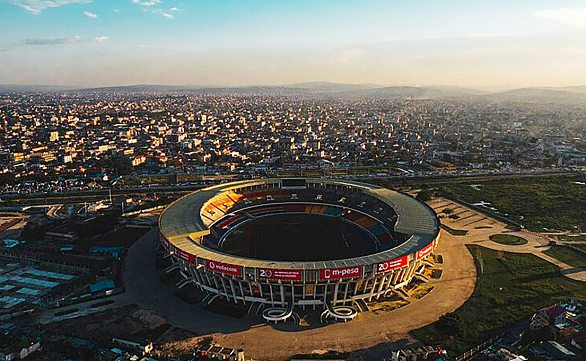Martyrs Stadium,
from sensation to sorrow
The Pentecost Martyrs Stadium (official name) is Africa's fourth largest stadium, with an 80,000-seat capacity. A concrete bowl in the centre of Kinshasa, a stone's throw from the equally renowned People's Palace, both urban monuments and testimonies to cooperation with China. It is here that the presidents of the Republic are sworn in, and it was here that the late Pope Francis celebrated Mass on 2 February 2023. The ‘Grande Marmite’ (Big Cauldron) as Kinshasans call it, is central to the country’s history and life.

Its construction began on 14 October 1988, on President Mobutu Sese Seko's birthday. He was a man who believed ‘the bigger the better’. The Chinese completed the project in 1994. Mobutu named the stadium Kamanyola, after a town in South Kivu where his troops crushed the Simba rebellion in 1964. It was also the name of his legendary boat, moored on the banks of the majestic Congo River in the N'sele Presidential Park, where the marshal liked to entertain guests on the aft deck, watching the sun set over the river with a glass of champagne in hand.
Three years after the stadium's inauguration, the Alliance of Democratic Forces for the Liberation of Congo (AFDL), supported by Rwanda and Uganda, crossed the country from east to west without encountering any resistance. On 17 May 1997, troops entered Kinshasa and brought down Mobutu Sese Seko's regime, which was on its last legs. Thirty-two years… such a long reign...
On 30 June 1997, Laurent-Désiré Kabila chose the stadium as the venue for his first major speech. The stadium was renamed the ‘Stade des Martyrs de la Pentecôte’ (Pentecost Martyrs Stadium) in honour of Jérôme Anany, Évariste Kimba, Alexandre Mahamba and Emmanuel Bamba, four former ministers in Patrice Lumumba's government who were accused in 1966 of conspiracy by the man then still known as Joseph-Désiré Mobutu, summarily tried and hanged on the esplanade of the future stadium. In May and June 1969, a series of student demonstrations broke out at Lovanium University (now the University of Kinshasa). On 4 June, the security forces (army and police) opened fire on a peaceful student demonstration, organised symbolically around the Christian festival of Pentecost. The exact number of deaths remains uncertain. Official figures at the time were downplayed, but witnesses spoke of dozens of victims.
Since the 1990s, besides the occasional exploits of national football team the Leopards, the Martyrs' Stadium had become the epicentre of Congolese music, where stars got real recognition from the Kinshasa crowds. Success in Paris, even at the Olympia, in New York or elsewhere, didn’t mean a thing. To be truly acclaimed, you had to have taken on the Stade des Martyrs. You had to have thrown down the gauntlet and shown who's the boss... From Papa Wemba and Wenge Musica Maison Mère, to torchbearers like Werrason, Bill Clinton Kalonji and Koffi Olomidé and his legendary group Quartier Latin, they all played Martyrs.
Fally Ipupa, who’d become master of his solo career, showed up to show off his style and rhythm, the tokooos, at the stadium in 2022. It was a major musical event. However, tragedy changed the history of the around120,000-strong audience, all ecstatic. And then… Eleven people died in the ensuing stampedes around and inside the stadium, including nine spectators and two police officers. An overcrowded venue, counterfeit tickets, organisational and policing failures... Everyone pointed the finger at each other. On 27 July, nine people were killed during a concert by one of the country's most famous gospel singers, Mike Kalambay. Again, the stands were overcrowded. The authorities announced they were opening an investigation to determine the circumstances of the tragedy. And the Ministry of the Interior declared that, from then on, all non-sporting activities would be banned from the Martyrs stadium. And also the Tata-Raphaël stadium.